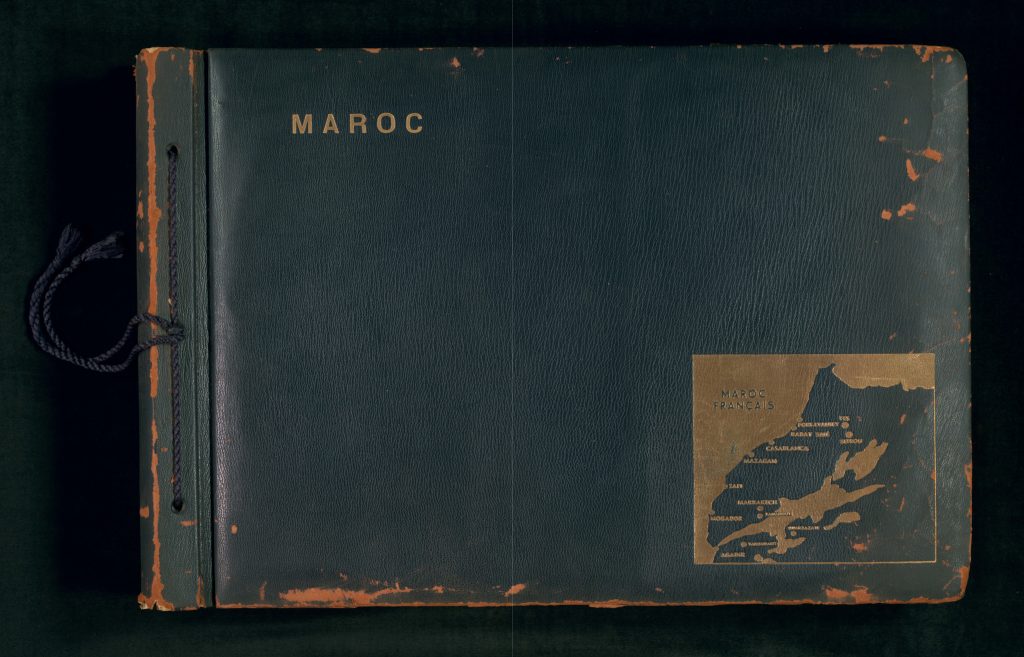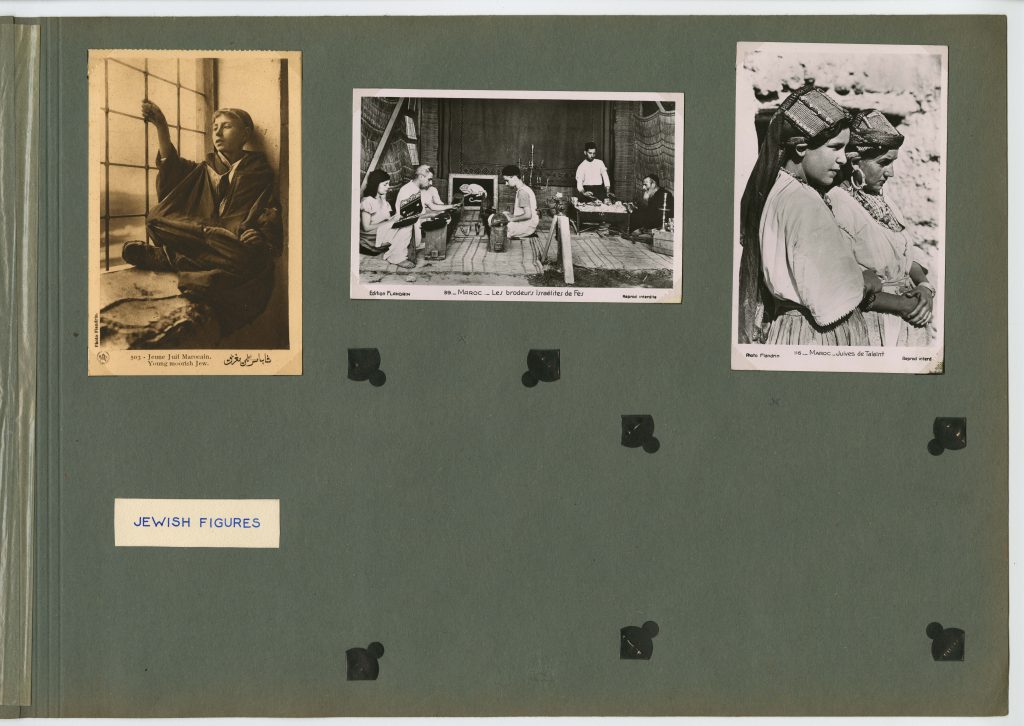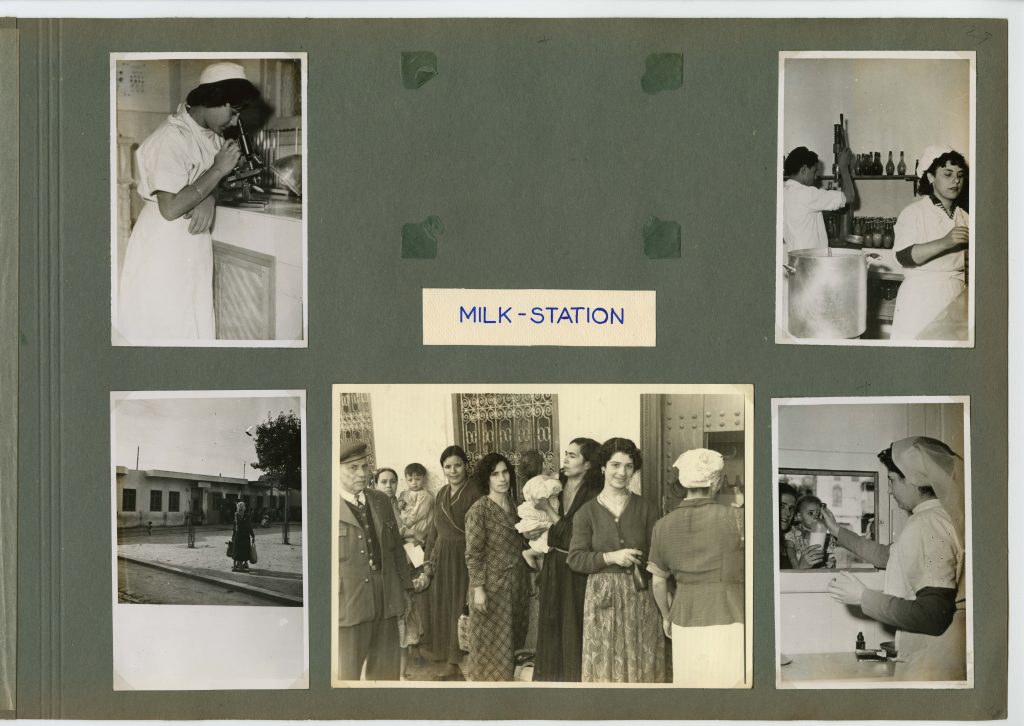June 10, 2024
By Julia Schulte-Werning, 2023-24 Bookhalter Graduate Fellow
Caring for Moroccan Jews: A Photo Album on Jewish Medical Aid in (Post)Colonial Morocco
The YIVO collections include a photo album that the Jewish aid organization OSE-Morocco had sent to the United States in September 1956 [see below]. Neatly pinned and accurately labeled, the images reveal the panorama of health care activities for Moroccan Jews in the early 1950s. At this time, Morocco was still a French and a Spanish protectorate. After World War II, the precarious legal status of approximately 250,000 Moroccan Jews and the living conditions in the overcrowded Jewish neighborhoods (the mellahs) became a major concern to local and international Jewish organizations. As part of the network of the health organization Oeuvre de Secours aux Enfants (OSE) and the American Jewish Joint Distribution Committee (JDC), OSE-Morocco started a medical aid program for Moroccan Jews, especially children. Throughout the late 1940s and 1950s, public health experts, physicians, nurses, and social workers offered general medical consultations for children and preventive health care for expectant mothers and newborns. Health workers conducted mass screenings and treatments of diseases and built up a school hygiene program.

In my PhD project, I explore how individual and collective responsibilities for the health of Moroccan Jews were negotiated from the late 1940s to the early 1960s and what the evolution of Jewish medical aid might tell us about visions of Jewish futures in the era of decolonization. Why did Jewish aid organizations become active on behalf of the Moroccan Jewish communities after the Holocaust, and what meanings did they attribute to issues of health and medical prevention? How were responsibilities and resources discussed and assigned between international Jewish organizations, local community bodies, and (post)colonial state authorities? How was the authority over children’s health and adequate care negotiated between medical professionals, “traditional” medical authorities and “laypeople” such as mothers and families? A closer look at the photo album provides insights into some of these aspects.

The 1956 album is a semi-public, semi-private document. Black-and-white photographs and colored printed postcards were attached to 60 cardboard pages and often contextualized with neat handwritten labels. Remnants of photo corners and glue marks indicate that about one quarter of the images are missing from the archived document. The first section presents the medical aid activities across French Morocco. The second section, entitled “Public-Relations,” shows official visits and celebrations. The album was most likely not meant for wide circulation but for a circle of co-workers, partners, friends, supporters, or visitors. For reaching a wider audience, the JDC and OSE relied on media like bulletins, annual reports, and fundraising campaigns. However, these spheres of circulation were not strictly separated; on the contrary, the images in use overlapped and converged.

The album´s prelude consists of two groups of images. It contains photographic prints with ethnographic and stylized motifs of persons in supposedly traditional attire and surroundings. These motifs continue throughout the activities chapter in which opening pages introduce the respective town with postcards and prints of picturesque scenery. Most of these commercial images were produced by Photo Flandrin, a studio which had shaped the French colonial imagery of an “exotic” Morocco to be “civilized” in the first half of the 20th century. In an age of emerging imperial tourism, these postcards were widely circulating consumer goods. As the album was addressed to the American section of OSE, drawing on an established visual language and reproducing a touristic gaze might have been a way of illustrating the sites not necessarily personally known to the addressee.

Their use, however, also testifies to the modernizing gaze with which international Jewish organizations regarded the groups they aimed to reform. Under the title “Children and Slums of the Mellahs,” another part of the prelude shows children and women in dark and unclean surroundings, apparently their living situations. These photos were most likely taken by JDC and/or OSE photographers. Taken together, the two sets of motifs bridge the “exotic” and the “suffering” while seemingly stemming from the realm of the “authentic” Moroccan-Jewish experience. It is here, as I am exploring in my research, that OSE and the JDC saw their sphere of intervention and the impetus to provide modern, efficiently structured health care. With this, the prelude sets the narrative tone of the album and can be understood as the “before” to the complementary “after” – a trope that highlights the transformative capacity of aid and was common in humanitarian visual narratives since the late 19th century.

Introducing the “after,” the first main section displays the aid activities in various towns of French Morocco. As scenes of the everyday operations of the dispensaries and medical services, we see patients lining up for registration, infants and young children being examined, weighed and treated for medical conditions, and children playing in bright and airy kindergartens and day care homes. The presentation of milk distribution in Fez [above] is an example for the professional impetus and the gender dynamics at play. A group of nurses prepares the milk bottles, while below we see women queuing. Like many other organizations occupied with the well-being of children, OSE-Morocco focused on the role of mothers for appropriate care and upbringing. Looking at the figure of the nurse and social worker as an intermediary and translator of health education and knowledge, I am exploring how notions of adequate childcare were negotiated and which responsibilities were assigned to the professional, the mother, the family, and the community.
The second album chapter presents visitors, delegations, and celebrations and is an indication of the broader Jewish aid networks in which OSE-Morocco was situated and of its relationship to the state. The early and mid-1950s were a period of intense political upheaval in Moroccan history – yet this context is notably absent from the album, where we find no clues on the turmoil of decolonization leading to independence from French and Spanish colonial rule in March 1956. As health and healing were inherently political issues in the French colonial project and in Moroccan nation-building, the meaning of establishing health care infrastructure for Jewish groups shifted with the political situation. Against the backdrop of the Holocaust and the antisemitic politics of the Vichy regime, members of the Jewish community were drawn to competing political visions of the future. As the Moroccan independence movement gained momentum in the postwar period, Jewish organizations were increasingly concerned about how inclusive the new Moroccan nation-state would be towards Jews, and emigration to Israel gained traction. Thus, questions of healthcare provide a lens through which to explore how visions of Jewish futures were negotiated in (post)colonial Morocco. Overall, I aim to contribute to a history of Jewish internationalisms and global public health in a post-Holocaust world marked by decolonization.
References:
OSE Activities in Morocco (album), 1956 September 18, YIVO, RG 494 OSE Photograph Collection, 1937-1962 Box 9, Folder 104 (Morocco2).
Boum, Aomar (2020): Rural Moroccan Jews and the Colonial Postcard. A Review Essay. In: Hespéris-Tamuda 5.
Fehrenbach, Heide (2015): Children and Other Civilians. Photography and the Politics of Humanitarian Image-Making. In: Fehrenbach, Heide und Rodogno, Davide (ed.): Humanitarian Photography. A History. Cambridge.
Goldsworthy, Patricia (2010): Images, Ideologies, and Commodities. The French Colonial Postcard Industry in Morocco. In: Early Popular Visual Culture 8.
Gottreich, Emily (2021): Jewish Morocco. A History from Pre-Islamic to Postcolonial Times. London.
Miller, Susan Gilson (2021): Years of Glory. Nelly Benatar and the Pursuit of Justice in Wartime North Africa. Stanford.
Michal Ben Ya’akov Lectures on Images of Moroccan Jews and Perceptions of American Jews, 1942-1954, JDC Archives Lecture, Webinar 2019.




